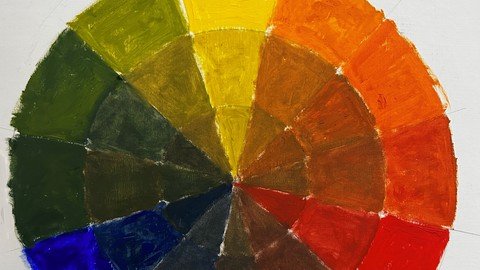
Published 5/2023
MP4 | Video: h264, 1280x720 | Audio: AAC, 44.1 KHz
Language: English | Size: 4.86 GB | Duration: 3h 54m
Color Theory, Color temperature, Hue, Saturation and Value, Limited Palettes
Free Download What you'll learn
Importance of Color Wheels and how to create one
How to differentiate Hue, Saturation and Color
Importance of Color Temperature
How to create color swatches of different color palettes
What a limited palette is and why you should try using them
Putting it all together with a still life painting
Requirements
Some basic experience with painting (acrylic or oil)
Painting surface (canvas, wood panel or similar surface)
2-4 paintbrushes of various sizes
A palette knife will help with color mixing but is not required
I recommend the following paints in the list below, but there are alternatives. You should at least have a darker cooler version and a lighter warmer version of each color.
Cerulean Blue, Ultramarine Blue, Alizarin Crimson, Cadmium Red Light, Cadmium Yellow Light, Yellow Ochre, Ivory Black, Titanium White
Description
In the context of visual art, color theory is the relationship between colors and the impacts certain color combinations have on a painting. Color theory is fundamental to painting whether you are a realist painter or an abstract one. The importance of understanding color theory goes beyond simply knowing how to mix two colors together. When you understand the relationship between colors your paintings will be more appealing to the eye and evoke different emotions from the viewer depending on the color combinations you use. This course is set up for any painting experience level. Even the absolute beginner can follow along. In this course you will learn: The importance of color wheels and how to make themWhat a limited palette is, how to create color swatches and the importance of practicing themThe difference between hue, saturation and value and why they are important to a successful paintingHow color temperature plays a role in your paintingsHow to apply all these techniques with two final project demonstrations that you can set up at homeThis course is taught using oil paints but can be done using acrylic paints as well, which every you are more comfortable with.
Overview
Section 1: Introduction
Lecture 1 Introduction
Lecture 2 Suggested Materials
Section 2: Color Theory Terms
Lecture 3 Definitions
Section 3: Color Wheels
Lecture 4 Video Demonstration
Section 4: Limited Palettes
Lecture 5 Video Demonstration
Section 5: Hue, Saturation and Value
Lecture 6 Video Demonstration
Section 6: Color Temperature
Lecture 7 Color Temperature
Section 7: Project 1: Reds Everywhere
Lecture 8 Reds Everywhere
Section 8: Project 2: Is the box green?
Lecture 9 Is the box green?
Section 9: Conclusion
Lecture 10 Concluding Remarks
Section 10: Additional learning
Lecture 11 How to create the color black
Immediate painters who want to learn more about color mixing and how colors interact. Painters that want to take their paintings to the next level by learning how to incorporate harmonious colors.,Beginning painters that want to learn the basics of color theory.
Homepage
https://www.udemy.com/course/color-theory-and-color-mixing/
Buy Premium From My Links To Get Resumable Support,Max Speed & Support Me
Links are Interchangeable - Single Extraction
Comments

